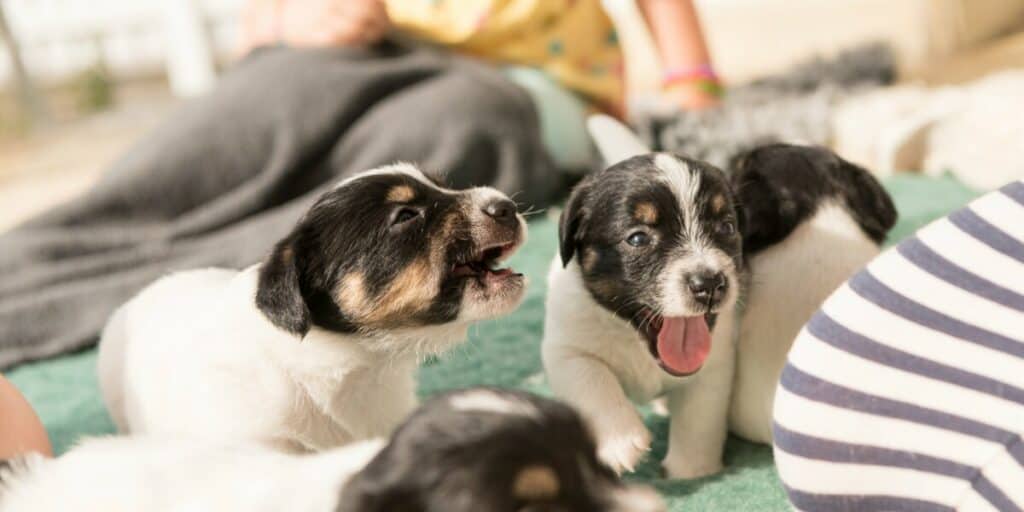
Waiting for a dog to have puppies can be an exciting and stressful rollercoaster of emotions. When the day finally comes, there is a lot of anticipation for little puppies running around, but things do not always go as expected. Sometimes, dogs only have one puppy. What causes this to happen?
Singleton puppy syndrome is when a mother gives birth to a single puppy rather than a regularly sized litter. This is rare and can cause issues for the puppy growing up without a litter. The puppy will need additional attention and care in areas such as physical contact and social interactions.
These young puppies can grow up to be normal, but without the help of a litter, they will require additional attention and training. Luckily, there are lots of ideas on how to keep your puppy socially adept and well-behaved, even when raised alone.
What is Singleton Puppy Syndrome?
Singleton Puppy Syndrome causes female dogs to give birth to one puppy rather than multiple. It is rare, but not uncommon. There are, however, ways that this puppy will need additional care to help it grow up and be a well-behaved pet for many years to come.
You may consider allowing your singleton puppy to join another litter for the first few weeksof its life or take additional measures at home. Either way, there is no reason to panic about the fate of your puppy.
How will Singleton Puppy Syndrome Affect the Puppy?
As mother nature has shown us, being raised in a litter is the most ideal situation for a newborn puppy. When raised without a litter, singleton puppies can struggle with selfish dominance in character, fear of enclosures, bite inhibition, and physical contact. Puppies benefit largely from early interaction with their littermates. In some ways, this acts as a free dog preschool!
The lessons puppies learn in their first 3 to 12 weeks of life have lifelong effects on their temperament, tendencies, understanding, and behavior. While interacting with other puppies for at least 7 of these weeks, puppies are exponentially more inclined to exceed others in good temperaments as adults.
Bite Inhibition
Many puppies learn about bite inhibition during this time. When playfully nudging, tugging, or pulling on each other's tails and fur, other puppies will yelp or bark their sibling has gone too far. This system allows young pups to learn how to “play nicely” and stay within certain limits of interaction that will keep their friends happy too.
Singleton puppies do not benefit from this safe early learning and will need extra help to understand what is safe and what is too aggressive. They will not learn how to not bite too hard without being personally taught what is acceptable.
Physical Contact
Typical puppy litters range from 3 to 12 puppies, providing lots of small bodies for them to experience physical contact. This body warmth and touch will help the puppies to be calm and feel safe when around other dogs and people. Crawling over other puppies and playing around is extremely important in the healthy development of a puppy.
Without this early contact, singletons often struggle with fears of being touched or handled. They can grow isolated and aggressive when touched if not helped to learn otherwise.
Overdominance
Newborn puppies also learn about the pecking order while in these early stages. They take turns nursing their mother and receiving care from her. Puppies grow accustomed to finding other means of entertainment and are not completely reliant on their caretakers for constant attention and care.
Singletons naturally inherit a sense of dominance from being the center of attention in their early years. This can make them extremely difficult to train, and can also make them aggressive with other dogs and people.
How to Raise a Singleton Puppy

Singleton puppies don't come with built-in playmates, but there are still ways to help them grow up to be wonderful pets! Luckily, there are things that you can do to help fill in this need for them, it may just take a bit more involvement and effort on your part to help them get there.
Adoptive Litter
Clearly, there are many aspects of growing up in a litter that will help a puppy learn and grow to be a well-rounded pet. This is why one of the most ideal situations for a singleton puppy is to be placed in an adoptive litter for as much time as possible. You could take it over for “play dates” or even leave the singleton with the litter for a few weeks.
This will help the puppy grow up in as close to a normal environment as possible. It will diminish or eliminate most, if not all, of the issues that regularly accompany singleton puppies.
Bite Inhibition
Singleton puppies will need help with bite inhibition. As is true with the majority of issues posed by Singleton Puppy Syndrome, time spent with other young puppies will help the singleton immensely when learning to establish limits when playing. Speak with your veterinarian about helpful toys and ways to teach the puppy bite inhibition early on.
Owners, too, can help with this. When the puppy bites too hard or is too rough, yelp out in pain to show the puppy what it has done. Young puppies communicate hurtful and playful actions by yelping and yapping at one another to signal pain, and you can do that as well.
Early Handling and Regular Contact
To help the puppy avoid the fear of physical touch or contact, handle the singleton regularly. This includes any gentle and regular contact such as holding, petting, or rubbing the puppy often. Again, having the puppy spend time with other young pups can be an invaluable resource in helping it to naturally grow and learn.
Another important aspect of physical contact is the natural feelings of being pushed, crowded, and enclosed. One singleton puppy owner used small stuffed animals, stuffed dogs clearly are ideal, and placed them tightly around the puppy when nursing, to simulate this type of interaction.

Cindy is a prolific writer and online researcher who can't imagine life without dogs. There is scarcely a dog topic she has not researched or written about. Her love for dogs and helping dog parents is evident by the thousands of dogtemperament.com visitors who read her articles monthly. Most of all, each topic Cindy writes on helps forge a stronger bond and understanding between her and her happy Catahoula Leopard Dog Jossie.